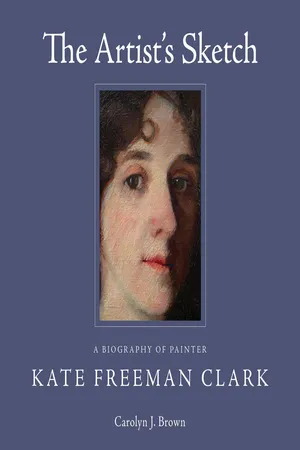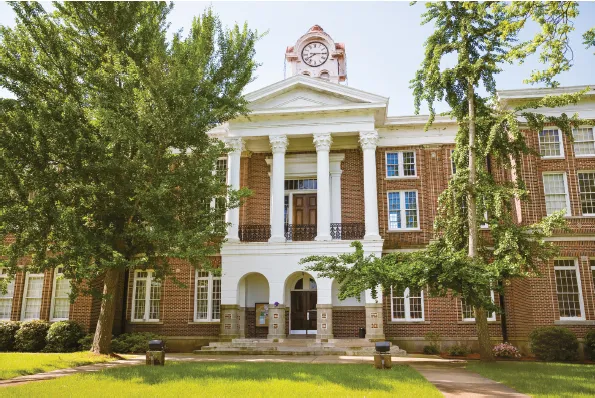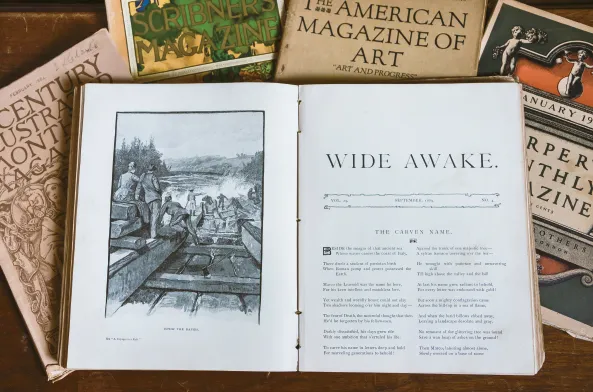![]()
Kate Freeman Clark’s house today, Holly Springs, Mississippi.
The Early Years: 1875–1893
Shall I be an authoress or an artist or neither?
Only a commonplace everyday girl?
—Kate Freeman Clark, Journal, July 2, 1893
HISTORIAN HODDING CARTER WRITES IN HIS INsightful essay, “A Proud Struggle for Grace: Holly Springs, Mississippi,” that “in Holly Springs one soon becomes aware of a curiously perceptible interlocking of life and death, of past and present.” This observation has certainly proven true in connection to the life of the artist Kate Freeman Clark, as the city has not dramatically changed since 1875, the year that she was born. The house to which she was brought home as a baby still stands, as does Christ Episcopal Church, where her grandmother played the organ and where she was baptized. The square, only a few blocks from the house, remains the heart of the town, with the historic courthouse residing at its center and surrounded by businesses on all four sides. Today these businesses sell modern merchandise and cuisine, but they still occupy and resemble the buildings of the past, such as Angie’s Boutique, which has opened in the former I. C. Levy clothing store and retains Levy’s signature on the side of the building and in tile in the front. A major reason tourists continue to flock to Holly Springs in April is to visit the historic homes, such as Montrose and Burton Place, which were built in the 1840s and ’50s and feature Greek revival and federalist architecture respectively. All these buildings and homes have been lovingly restored and still stand today as they did in the 1870s when Kate was a young girl.
Kate Freeman Clark’s home, known in Holly Springs as both the Walthall House and Freeman Place, belonged to Kate’s namesake and grandmother, Kate Walthall Freeman, who moved in after the death of her father, Barrett Walthall, in 1881. Walthall was one of the founders of the city and its first mayor, and he built the house in 1848. The house was not exceptionally large but was comfortable and included an impressive library for the time. Kate had access to a variety of books and periodicals, and her mother and grandmother often read to her. Carter stated that Holly Springs was a city known for its history of “institution-mindedness,” and “even before the town’s incorporation, they voted in a town meeting to establish the Holly Springs Female Institute and before it was built they had erected a home for the Literary Institute for boys.” However, in the 1870s and ’80s, the “Athenian quality [of] the little town” had disappeared, ravaged by war, Reconstruction, and the yellow fever epidemic of 1878. According to the WPA Guide to the Magnolia State, “Hardly had the town recovered from war and reconstruction when it was struck by the yellow fever epidemic of 1878, which reduced the population by about half.” For all these reasons, schools were no longer the impressive academic institutions that they once were, and institutions were actively seeking funds to rebuild after structures were lost or severely damaged in the war. It was fortunate that during this time Kate had a library available to her because her family’s love of books nurtured within her a love of the written word.
A block of the town square, Holly Springs. The I. C. Levy store is still remembered on the exterior wall.
Holly Springs courthouse, which sits in the center of the town square.
Her earliest diaries and journals, written from 1888 through 1893 when she was between twelve and eighteen years of age, show a Kate Freeman Clark besotted with words. She copied favorite quotes from philosophers and poets and composed little stories that varied wildly in content from the historical (Hampton Court, the Revolutionary War), to the relatively ordinary (cats, her minister), to the creative (imaginary games she played with her friends), and, not surprisingly, to the romantic (a lost engagement ring, young love). These vignettes entertain and amuse; they raise questions and describe settings. In one entry from April 2, 1888, she wondered how Sunflower County got its name, and wrote, “[I]f it resembles its name it must be pretty.” In another example she described the creative solution of two young girls who, separated by a fence they could not climb over, took a pole and “put it through a crack” to create a seesaw. And, in another short anecdote entitled “Our Minister,” she humorously called the clergyman “a calamity upon the parish.”
These early writings introduce not only a clever and thoughtful young girl, but also one who was stirred by beauty. Kate often wrote about flowers. Again, on April 2, 1888, when she was twelve, she said, “To see them, morning glories, winding around everything or on a trellis or running over a cottage, is the very picture of domestic happiness.” In a short story entitled “The Springtime of Life,” written in her diary in March 1891, Kate vividly described an array of flowers:
It was a pretty spot, an old gate some of the bars were down and on the one remaining sat a young girl. Her hat had blown off her head and was hanging by its pretty ribbons from her fair neck displaying to advantage the fine golden hair which fell in lovely curls around her beautiful face and well formed shoulders. In her hand she held a large bunch of pink clovers and daisies interspersed with fine green grasses. From her apron, one corner of which she held in her other hand, peeped a spray of wild roses and a cluster of honeysuckle which had just been thrown down by a boy several years older than herself who was seated upon the post gathering wild honeysuckle from a vine which ran on a tree nearby.
Books from the Clark family library. The library is comprised of 250 to 300 volumes and can be viewed at the Marshall County Historical Museum. Courtesy of MCHM.
A sampling of magazines that can be found in the Clark family library at the Marshall County Historical Museum. Courtesy of MCHM.
The detail is so rich the scene could easily be transformed into a painting.
Other entries reveal her hopes of becoming an “authoress.” On September 16, 1888, Kate stated, “[I have] made up my mind to keep a diary.” And she reaffirmed this commitment almost to the day a year later: on August 30, 1889, she wrote, “I have decided to keep a diary if I can remember to.” However, three days later she complained about a lack of subject matter: “I have nothing to write except Shay moved her kittens upstairs today in a box with some cotton in it. Their names are Pleasure, Fun, and Frolic. I am reading a charming book called “On Both Sides” so very funny by Frances Courtenay Baylor.” Generally, she did find worthy subjects to write about, as she journaled and experimented with all kinds of writing for much of her life.
Four years later, Kate, then seventeen years old, expressed more frequently her love of books, her favorite authors, and a fervent desire to become a writer herself. On January 5, 1892, she declared she would attempt to write her first novel: inspired by Sir Walter Scott’s Peveril of the Peak she wrote, “If I am ever to be an authoress I might as well begin.” However, she lacked confidence in her writing ability because she could not come up with a plot. Instead she distracted herself from writing by reading another Scott novel, The Fortunes of Nigel. When she did finally put pen to paper, she bewailed her ability: “Wrote the first chapter in my story today.… My style is so dry and uninteresting.” Despite her lack of confidence, she stuck with her manuscript and wrote a second chapter because “It has always been my purpose to be an authoress ever since I was a very little thing but I need schooling especially in the English branches.”
Although it appears her goal was to become a published writer, Kate ...







